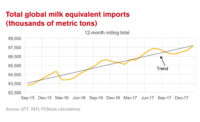
Changes to Price Reports Up for Grabs
by Stephen Barlas, Washington Editor
The Agriculture Department is considering whether to make changes in the mandatory product price reporting program that went into effect in early August.
Manufacturers of nonfat dry milk, cheese, butter and
dry whey are pushing the USDA to clarify what kinds of sales are covered
with respect to forward contracts and the deadline for setting the prices
for those contracts in order for the sales prices to be included in the
weekly reports dairy manufacturers send to the USDA’s National
Agricultural Statistics Service (NASS). Reporting has been voluntary since
2000, and almost all dairy product companies have complied.
As always with dairy policies established by the
USDA’s Agricultural Marketing Service, the mandatory reporting
dictate is part of a very complex system. In general terms, manufacturers
of cheese, butter, nonfat dry milk and whey report the prices they receive
for their products, how much of each they sold and, in the case of barrel
cheese, the moisture content of the product. The AMS takes the data in
those reports and establishes, on a monthly basis, the minimum price for
each of the four classes of milk, e.g. Class II (yogurt, ice cream and
cottage cheese). Those minimum prices are applied to all of the milk
marketing orders around the United States.
It is important that the price reports be accurate, of
course, because those reports dictate the intricate balance between prices
received by dairy farmers and the price of milk paid by the Deans and
Dreyer’s Grand Ice Creams of the world.
Lurking in the background here is the fact that some
manufacturers of nonfat dry milk included some long-term, fixed prices
sales data in their weekly reports in the recent past. NASS guidelines
explicitly exclude the reporting of forward pricing sales in which the
selling price was set 30 days or more before the transaction was completed.
NASS went back and obtained revised weekly reports from a number of
companies, which resulted in revisions of average weekly price of nonfat
dry milk ranging from -0.8 to 8.5 cents per between April 2006 and April
2007.
Of course, it was too late at that point to revise the
minimum milk price in the marketing orders. However, as a result, the AMS
estimated that dairy farmers lost about $50 million as the result of milk
prices being lower than they should have been had the nonfat dry milk
prices reported by dairy companies been accurate.
That political friction between dairy farmers and
dairy manufacturers hangs over the interim final rule the AMS published on
August 2. The agency asked for comments on some aspects of the mandatory
price reporting system, and got them in spades.
So there may be some changes to the mandatory
reporting program coming up. The big issue is the current requirement that
companies only report the prices they receive when those prices are set
within 30 days of the sale, except for sales through the Dairy Export
Incentive Program.
However, the National Milk Producers Federation wants
sellers of nonfat dry milk to include prices set up to 90 days before the
product ships in the case of export sales. Patty Stroup, group manager for
dairy at Nestlé Business Services, opposes that change to the
interim final rule, as do almost all other dairy product manufacturers.
“I don’t see any argument from milk producers that would
legitimize changing the interim final rule with regard to the 30-day
window,” Stroup says.
Stephen Barlas has been a full-time freelance
Washington editor for business and trade magazines since 1981.

